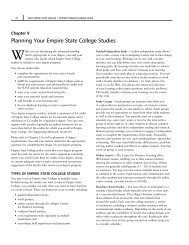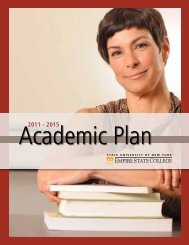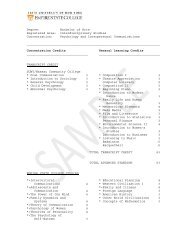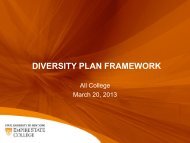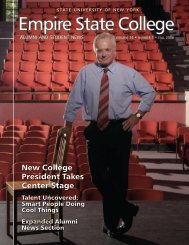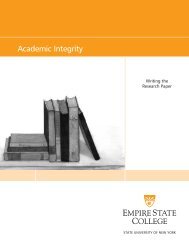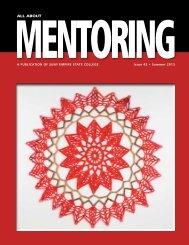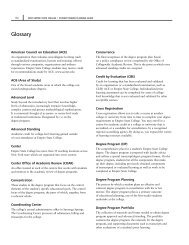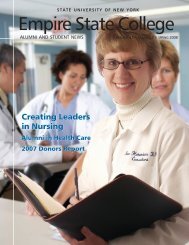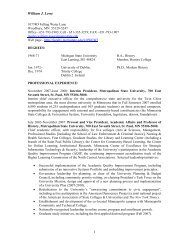All About Mentoring Spring 2011 - SUNY Empire State College
All About Mentoring Spring 2011 - SUNY Empire State College
All About Mentoring Spring 2011 - SUNY Empire State College
Create successful ePaper yourself
Turn your PDF publications into a flip-book with our unique Google optimized e-Paper software.
78<br />
Innovation, Disruption and Higher Education:<br />
Is There a Road Map for the Future<br />
Christopher Whann, Metropolitan Center<br />
A Review of:<br />
Christensen, C. (1997). The innovator’s<br />
dilemma: When new technologies cause<br />
great firms to fail. Boston: Harvard<br />
Business School Press.<br />
Christensen, C., & Raynor, R. (2003).<br />
The innovator’s solution: Creating and<br />
sustaining successful growth. Boston:<br />
Harvard Business School Press.<br />
Christensen, C., Horn, M., & Johnson,<br />
C. (<strong>2011</strong>). Disrupting class: How<br />
disruptive innovation will change the<br />
way the world learns. New York:<br />
McGraw-Hill. 1<br />
Christensen, C., Horn, M., Caldera, L., &<br />
Soares, L. (<strong>2011</strong>, February). Disrupting<br />
college: How disruptive innovation<br />
can deliver quality and affordability<br />
to postsecondary education. Retrieved<br />
from http://www.innosight.org<br />
Innovation is one of the most exciting<br />
topics in contemporary academic<br />
business research. One can easily<br />
lose track of the number of articles and<br />
conference papers about innovation,<br />
managing innovation, marketing innovation<br />
and innovation strategies. If anyone can be<br />
considered the leader of this field, Clayton<br />
Christensen of the Harvard Business School<br />
is certainly among the top candidates.<br />
Christensen’s 1997 book, The Innovator’s<br />
Dilemma, is a fascinating exposition of<br />
how what he describes as “disruptive<br />
technologies” can overtake an industry,<br />
and how good management is no guarantee<br />
of success in the face of massive change.<br />
In The Innovator’s Solution, Christensen<br />
follows up on this theme by discussing<br />
how firms and managers can sustain an<br />
advantage in an organization. Christensen<br />
and his co-authors turn their sights on K-12<br />
education in Disrupting Class, in order to<br />
analyze how their findings from industrial<br />
(often high-tech) settings might apply to the<br />
controversies surrounding an educational<br />
system often described as in crisis. In<br />
February <strong>2011</strong>, he and his co-authors<br />
released Disrupting <strong>College</strong>, a report on<br />
innovation in university education.<br />
My goals in this essay are to outline some<br />
of Christensen’s key arguments in the larger<br />
discussion of innovation, and in doing so,<br />
to summarize some of his central themes.<br />
Within such a context, my hope is that<br />
we can start developing some ideas about<br />
how his insights might affect adult and<br />
distance higher education, which we would<br />
all agree is an area known for its claims<br />
for innovation. I do not pretend that this<br />
essay provides an exhaustive review of<br />
Christensen’s work, but his insights do offer<br />
us some guidance and some warnings about<br />
how we might respond to future challenges<br />
and opportunities.<br />
In effect, I think that <strong>Empire</strong> <strong>State</strong><br />
<strong>College</strong>, as a networked institution with a<br />
significant global and online presence, is an<br />
interesting case study of how an innovating<br />
organization may have become a “sustaining<br />
organization” and thus susceptible to<br />
being overtaken in a changing, competitive<br />
environment even with good or wellintentioned<br />
leadership.<br />
Differences in Degree and<br />
Differences in Kind<br />
Christensen has noted that he has spent<br />
decades in the halls of Silicon Valley<br />
businesses. He has met many excellent<br />
leaders and managers whose companies<br />
have gone out of business. In The<br />
Innovator’s Dilemma, Christensen describes<br />
the trajectories of firms producing disk<br />
drives, earth moving equipment, steel,<br />
computer printers and motorcycles, among<br />
others. He categorizes the technologies<br />
upon which these areas depend as either<br />
“sustaining” or “disruptive.” Technology,<br />
in the sense Christensen and his colleagues<br />
use it, basically refers to new products or<br />
processes that improve speed, efficiency<br />
or capability. Sustaining technologies are<br />
those that introduce differences of degree<br />
into a product or a process, so existing<br />
users can use the product or process better.<br />
Technologies that shave costs so products<br />
are more affordable or technologies that are<br />
markedly faster or more powerful are thus<br />
sustaining. On the other hand, disruptive<br />
technologies are those that introduce<br />
differences of kind, so new users can take<br />
advantage of the product or process. Over<br />
time, disruptive technologies can themselves<br />
become sustaining technologies, once they<br />
have been thoroughly and widely adopted.<br />
At their point of origin, Sony’s Walkman, or<br />
Nokia’s cell phone or Amazon’s Kindle, are<br />
examples of disruptive technologies.<br />
Using certain criteria, disruptive technologies<br />
are not necessarily as “good” as sustaining<br />
ones. Thus, for example, the Walkman<br />
was never as good as a high quality stereo<br />
system, but users could take it outside when<br />
they went for a walk (hence the name). An<br />
early Nokia cell phone would drop calls<br />
much more often than a Bell Telephone<br />
landline, but we were no longer attached<br />
to the wall or required to stay within 20<br />
feet of a base while we used it. The Kindle<br />
may not be as good as a beautifully bound<br />
hardcover book, but it is much lighter than<br />
carrying three or four books on the plane<br />
during an extended trip. In fact, one could<br />
argue that they are likely to be worse quality<br />
technologies, but they often fill a niche<br />
that consumers want or need and are more<br />
affordable than sustaining ones.<br />
While companies have an incentive to<br />
keep producing a better product for the<br />
customers and users they know they have,<br />
it is successful producers of disruptive<br />
technologies that can identify new<br />
consumers who may not need the best<br />
technology but need something “good<br />
enough” for a different purpose. Many<br />
traditional telephone-producing companies<br />
could make much better phones than<br />
before, and indeed they did, but they<br />
suny empire state college • all about mentoring • issue 39 • spring <strong>2011</strong>




